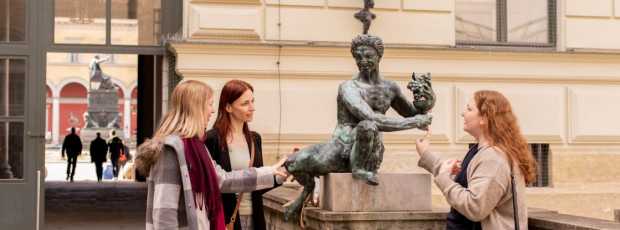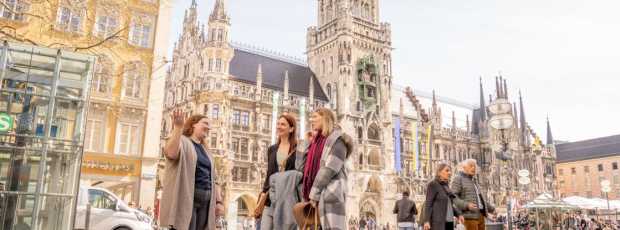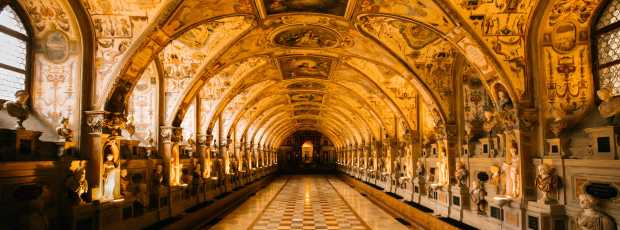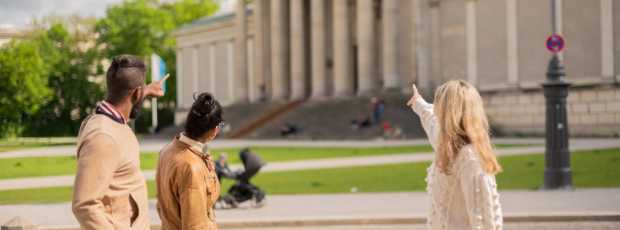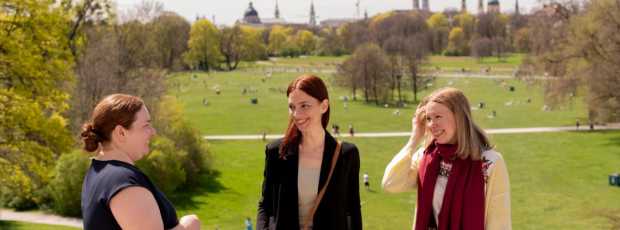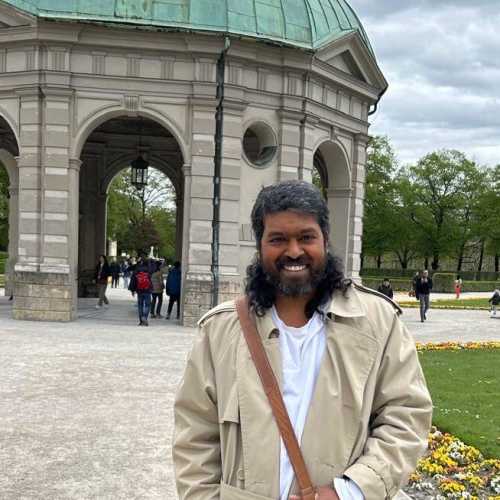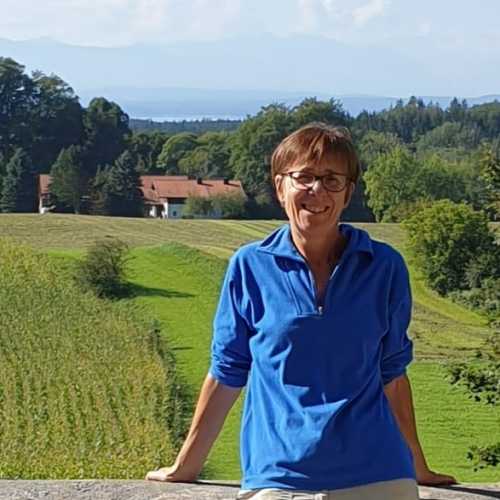Table Of Contents
- Day 1: Munich's Historic Core and Beer Culture
- Day 2: Museums, Parks, and Royal Palaces
- Day 3: Day Trip Options - History, Castles, or Modern Munich
- Practical Information for Your Munich Travel Itinerary
- Making the Most of Your Days in Munich
I've lived in Munich for fifteen years and have walked visitors through this city countless times. The itinerary below follows efficient routes between key sites, uses public transport strategically, and gives you time to actually absorb what you're seeing. You'll cover the essential Munich experiences without feeling like you're checking boxes.
This Munich itinerary assumes you have three full days in Munich. If you're working with less time, focus on Day 1's city center route first, then add elements from Days 2 and 3 based on your interests.
Day 1: Munich's Historic Core and Beer Culture
Morning: Marienplatz and the Old Town
Start your Munich travel itinerary at Marienplatz, the city's central square since 1158. The square serves as Munich's practical and symbolic center, with the U-Bahn and S-Bahn stations directly underneath providing easy access from anywhere in the city.
The New Town Hall dominates the square's north side. Built between 1867 and 1909, its Gothic Revival architecture intentionally evokes medieval grandeur while housing thoroughly modern municipal offices. The Glockenspiel performs at 11 AM and 12 PM daily (plus 5 PM from March to October), recreating historical Bavarian events through mechanical figures.
Walk to the Old Town Hall on the square's east side, a simpler Gothic structure from the 14th century that now houses a toy museum. The contrast between old and new town halls illustrates Munich's approach to urban development: preserve the essential character while adapting to practical needs.
From Marienplatz, walk northeast on Burgstraße toward the Munich Residenz. This route takes you through the oldest part of Munich's city center, where medieval street patterns remain largely intact. The narrow streets weren't designed for modern traffic, which is why Munich invested heavily in public transportation rather than widening roads.
Late Morning: Munich Residenz
The Munich Residenz served as the seat of Bavarian dukes, electors, and kings for over 400 years. The complex expanded organically from a 14th-century castle into a palace covering seven courtyards and 130 rooms.
The Treasury contains one of Europe's most valuable collections of royal regalia, including crowns, orbs, and ceremonial swords spanning eight centuries. The Antiquarium, a Renaissance hall built to house Duke Albrecht V's collection of classical sculptures, demonstrates Munich's early role as a center of learning and culture.
Allow 90 minutes for the Residenz, focusing on the Treasury and state rooms. The audio guide provides context for the political relationships that shaped Bavaria's development within the Holy Roman Empire and later Germany.
Afternoon: Beer Halls and Bavarian Tradition
Walk south on Max-Joseph-Platz past the National Theater to reach Platzl, home to the Hofbräuhaus, one of Munich's most famous beer halls, established in 1589. Hofbräuhaus operates as both tourist attraction and functioning brewery/restaurant. The ground floor maintains the traditional communal seating arrangement where strangers share long wooden tables.
Order a Maß (one-liter beer) and traditional Bavarian food like Schweinshaxe (pork knuckle) or Weisswurst (white sausage). The atmosphere can be overwhelming, especially during peak hours, but it provides an authentic introduction to Bavarian beer culture and social customs.
After lunch, walk west through the old town toward Viktualienmarkt, Munich's central food market. The market has operated on this site since 1807, evolving from a farmers' market into a gourmet food destination while maintaining its role as a neighborhood grocery source.
The market's beer garden, unlike most Munich beer gardens, allows you to bring food purchased from the surrounding stalls. This flexibility makes it an ideal spot to sample local specialties like Leberkäse (a type of meatloaf) or fresh pretzels while observing daily Munich life.
Evening: Traditional Beer Gardens
For dinner, choose between two excellent beer gardens within walking distance of the city center. The Augustiner-Bräu, Munich's oldest brewery (founded 1328), operates a beer garden on Arnulfstraße that attracts more locals than tourists. The beer comes from wooden barrels, following traditional serving methods.
Alternatively, visit the Löwenbräu-Keller near the main train station. This beer garden offers a quieter atmosphere and excellent roasted chicken, a Munich specialty. Both locations close around 11 PM, giving you time to return to your accommodation via public transport.
Day 2: Museums, Parks, and Royal Palaces
Morning: BMW Museum and Olympic Park
Take the U3 line to Olympiazentrum station to reach BMW Welt and the BMW Museum. This trip takes about 20 minutes from the city center.
BMW Welt, the company's delivery and exhibition center, displays current models and concept cars. The building itself, designed by architect Wolf Prix, demonstrates contemporary German engineering and design principles. Entry is free, making it an excellent starting point for car lovers and architecture enthusiasts alike.
The adjacent BMW Museum chronicles the company's evolution from aircraft engine manufacturer to luxury car producer. The museum emphasizes technical innovation and design philosophy rather than simply showcasing vehicles. Interactive exhibits explain how BMW's engineering principles apply to both motorcycles and automobiles.
Walk north from BMW Welt to the Olympic Tower, built for the 1972 Summer Olympics. The 290-meter tower offers panoramic views of Munich and the Bavarian Alps on clear days. The elevator ride takes 30 seconds, and the observation deck includes displays explaining Munich's urban development from medieval town to modern metropolis.
Afternoon: English Garden and Chinese Tower
Return to the city center via U3 and walk east to the English Garden, one of the world's largest urban parks. Created in 1789 by American-born Count Rumford, the park follows English landscape design principles emphasizing natural-looking spaces over formal gardens.
The park's southern section contains the most popular attractions, including the Chinese Tower beer garden and the Eisbach wave where surfers practice year-round. The beer garden at the Chinese Tower operates seasonally and offers a more relaxed atmosphere than the city center beer halls.
Walk north through the park to observe Munich's outdoor culture. On weekends, you'll see families picnicking, students studying, and amateur musicians practicing. The park serves as Munich's primary recreational space, demonstrating how the city balances urban development with green space preservation.
The Eisbach wave, near the park's southern entrance, attracts surfers despite Germany being landlocked, hundreds of kilometers from the ocean. This artificial wave, created by water flowing over concrete structures, has become a symbol of Munich's innovative approach to urban recreation.
Late Afternoon: Nymphenburg Palace
Take tram 17 from the city center to Nymphenburg Palace, the summer residence of Bavarian royalty. The palace complex, built between 1664 and 1758, demonstrates baroque architecture adapted to German climate and landscape.
The main palace contains the Gallery of Beauties, commissioned by King Ludwig I, featuring portraits of 36 women from various social classes. This collection reflects the king's aesthetic interests and provides insight into 19th-century beauty standards and social attitudes.
The palace park, designed in French formal style and later modified to include English landscape elements, covers 200 hectares. Walking the full circuit takes about 90 minutes, but you can focus on the central axis from the palace to the cascade for a shorter visit.
The Marstallmuseum, located in the former royal stables, displays ornate carriages and sleighs used by Bavarian royalty. The collection includes Ludwig II's wedding carriage, never used due to his mysterious death in 1886.
Evening: Schwabing District
Return to the city center and explore Schwabing, Munich's former bohemian quarter. Take the U3 or U6 to Münchner Freiheit station and walk along Leopoldstraße, Munich's boulevard lined with cafes, restaurants, and shops.
Schwabing attracted artists and intellectuals in the early 20th century, including Wassily Kandinsky and Thomas Mann. While gentrification has changed the neighborhood's character, it retains a concentration of galleries, bookshops, and independent restaurants.
For dinner, try traditional Bavarian cuisine at Augustiner-Bräu Klosterwirt on Leopoldstraße or explore international options reflecting Munich's cosmopolitan character. The neighborhood offers numerous options for live music and evening entertainment.
Looking for a private city experience in Munich?
Explore the city with a local who plans a private day just for you; no groups, no scripts.
Day 3: Day Trip Options - History, Castles, or Modern Munich
Your third day in Munich offers several excellent day trip options, each providing different perspectives on Bavarian history and culture. Choose based on your interests and energy level.
Option 1: Dachau Concentration Camp Memorial Site
Take the S2 train to Dachau station (25 minutes from Munich Hauptbahnhof), then the 726 bus to the memorial site. This memorial site preserves the first Nazi concentration camp, established in 1933 primarily for political prisoners.
The memorial site includes reconstructed barracks, the former administration building (now a museum), and various monuments commemorating the victims. The museum provides historical context through photographs, documents, and personal testimonies from survivors.
Plan three to four hours for a thorough visit. The site offers guided tours in multiple languages, though the self-guided audio tour allows you to proceed at your own pace. The memorial site serves as an important historical education site and operates as a free place for visitors to learn about this period of German history.
The journey back to Munich takes about 45 minutes, giving you time to process the experience before continuing with evening plans in the city.
Option 2: Neuschwanstein Castle
For a more traditional tourist experience, take the train to Füssen (2 hours from Munich) to visit Neuschwanstein Castle, King Ludwig II's fairy-tale castle built between 1869 and 1886. This day trip requires advance booking and a full day commitment.
The castle tour takes 35 minutes and covers 14 rooms, including the throne hall and singer's hall inspired by Wagner's operas. The castle's romantic architecture influenced Disney's Sleeping Beauty Castle and represents the pinnacle of 19th-century romantic architecture.
The surrounding Bavarian Alps provide spectacular scenery year-round, with hiking trails accessible from the castle area. The nearby village of Hohenschwangau offers restaurants and shops, making it easy to spend a full day exploring the region.
Plan to return to Munich by early evening, as the train journey back takes two hours. This day trip works best during late spring through early fall when weather conditions are most favorable for outdoor exploration.
Option 3: Modern Munich - Allianz Arena and Olympic Park Extended Visit
For a more relaxed third day, explore Munich's modern architecture and sports culture. Start with a guided tour of the Allianz Arena, FC Bayern Munich's home stadium since 2005.
The stadium tour includes the players' tunnel, press conference room, and VIP areas. The building's innovative facade changes color based on which team is playing, demonstrating how modern architecture can create dynamic visual experiences.
After the stadium tour, return to Olympic Park for a more thorough exploration. The park's architecture, designed for the 1972 Summer Olympics, pioneered the use of tent-like structures and cable-net roofs. The design emphasized transparency and lightness, departing from the monumental architecture associated with previous Olympic Games.
Visit the Olympic Museum to learn about the games' impact on Munich's urban development. The museum explains how the Olympics accelerated Munich's transformation from a traditional Bavarian city into a modern European metropolis.
Spend the afternoon exploring the park's recreational facilities, including walking paths, swimming areas, and sports venues still in active use. The park demonstrates how Olympic infrastructure can be successfully integrated into urban recreational systems.
Practical Information for Your Munich Travel Itinerary
Public Transportation
Munich's public transportation system consists of the U-Bahn (subway), the S-Bahn (suburban rail), trams, and buses. A 3-day ticket costs approximately €20 and covers all zones within the city limits, including trips to Nymphenburg Palace and the airport.
The U-Bahn operates from 4 AM to 1 AM on weekdays (2 AM on weekends), with trains running every 5-10 minutes during peak hours. Download the MVG app for real-time schedules and route planning.
Key transport hubs include Hauptbahnhof (central station), Marienplatz, and Sendlinger Tor. These stations connect multiple lines and provide easy access to most tourist attractions within the city center.
Beer Garden Etiquette
Munich's beer gardens follow specific social customs that enhance the experience when understood. At traditional beer gardens, you may bring your own food but must purchase drinks on-site. Self-service areas are clearly marked and typically cost less than table-service sections.
Communal tables encourage conversation with strangers, reflecting Bavaria's social drinking culture. Don't be surprised if locals share your table and engage in friendly conversation, especially during busy periods.
Most beer gardens close around 10-11 PM, earlier during winter months. Many operate seasonally, typically from April through October, depending on weather conditions.
Weather Considerations
Munich's weather varies significantly by season, affecting which activities work best during your visit. Summer temperatures range from 15-25°C (59-77°F), ideal for beer gardens and outdoor walking. Winter temperatures drop to -5 to 5°C (23-41°F), making indoor attractions like museums and the Residenz more appealing.
Rain occurs frequently throughout the year, so pack appropriate clothing regardless of season. Many indoor attractions, including beer halls and museums, provide excellent alternatives during inclement weather.
Alternative Options and Flexibility
This Munich itinerary provides a framework rather than a rigid schedule. If you're particularly interested in contemporary art, substitute the BMW Museum with visits to the Pinakothek der Moderne or Lenbachhaus. These museums showcase modern art collections and provide insight into Munich's role in contemporary cultural movements.
For shopping enthusiasts, replace afternoon museum visits with exploration of shopping streets like Maximilianstraße (luxury brands) or Pedestrian Zone around Marienplatz (department stores and international chains). Munich offers excellent shopping opportunities that rival other major European cities.
If you prefer a more active approach, consider joining a Munich walking tour that focuses on specific themes like Third Reich history, architectural development, or culinary traditions. Unlike generic group tours, customized walking experiences allow you to explore specific interests while learning from local experts who understand the city's layered history.
Food and Dining Recommendations
Beyond the famous beer halls, Munich offers diverse dining options reflecting both traditional Bavarian cuisine and international influences. For breakfast, try Rischart bakery locations throughout the city for fresh pretzels and coffee.
Traditional restaurants like Ratskeller München (located beneath the New Town Hall) serve authentic Bavarian dishes in historic settings. For modern interpretations of regional cuisine, explore restaurants in the Glockenbachviertel district, south of the city center.
Many restaurants close between lunch and dinner service (typically 2:30-5:30 PM), so plan accordingly. Reservations are recommended for dinner at popular establishments, especially during festivals and peak tourist seasons.
Museum and Attraction Practicalities
Most Munich museums close on Mondays, so plan your museum visits for Tuesday through Sunday. Many museums offer reduced admission rates for students, seniors, and families. The Munich Museum Pass provides access to over 40 museums and costs €29 for three days.
Popular attractions like Neuschwanstein Castle require advance reservations, especially during summer months. Book tickets online at least two weeks before your visit to ensure availability.
Free attractions include most church visits, walking through the English Garden, exploring Viktualienmarkt, and observing the Glockenspiel performance at Marienplatz.
Making the Most of Your Days in Munich
Munich rewards visitors who take time to understand the city's character rather than rushing through a checklist of attractions. The city's appeal lies in its successful balance of traditional Bavarian culture with modern European sophistication.
This three-day Munich travel itinerary covers the essential experiences while allowing flexibility for personal interests. Whether you're drawn to historical sites, cultural institutions, outdoor recreation, or culinary experiences, Munich provides high-quality options that justify the time invested in exploration.
The key to enjoying Munich is adopting the local pace: thorough rather than hurried, social rather than solitary, and appreciative of both historical depth and contemporary innovation. This approach transforms a standard city visit into a deeper understanding of how traditional European cities successfully adapt to modern life while preserving their essential character.
Remember that Munich serves as an excellent base for exploring Bavaria more broadly. If you have additional time, consider extending your stay to explore the Bavarian Alps, other historic cities like Regensburg or Bamberg, or additional castles built by King Ludwig II. The public transportation connections make these extended explorations easily doable from Munich as a central hub.
Your Munich travel itinerary should ultimately reflect your interests while taking advantage of the city's efficient organization and high-quality attractions. The suggestions above provide a tested framework that has worked well for countless visitors seeking to explore Munich thoroughly in three days.
What if your day in Munich was planned by someone who knows it — and you?
City Unscripted matches you with a local host who creates a private experience based on your interests, not a set route.
Tip
We match you with the right host, not just any guide.Want to experience the real Munich with someone who lives there?
A fully private experience, planned and led by a local host who tailors the day to you
Ready to plan your perfect day in Munich?
Start your experienceWhat if your day in Munich was planned by someone who knows it — and you?
City Unscripted matches you with a local host who creates a private experience based on your interests, not a set route.
Want to experience the real Munich with someone who lives there?
A fully private experience, planned and led by a local host who tailors the day to you


